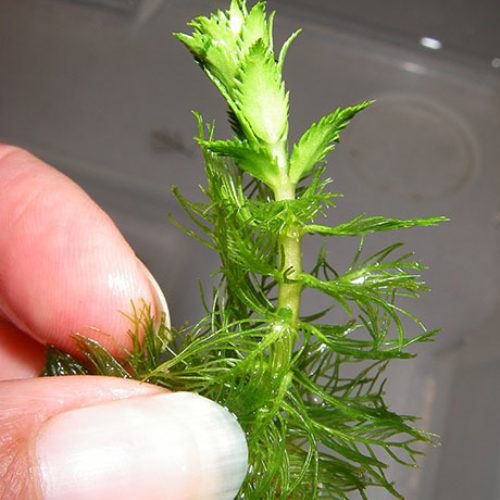Variable-Leaf Milfoil, and Hybrid variable-leaf milfoil
Myriophyllum heterophyllum, Myriophyllum heterophyllum x Myriophyllum hippuroides

Family: Haloragaceae
Other Common Names: variable watermilfoil, two-leaved watermilfoil, broadleaf watermilfoil, variable leaf watermilfoil hybrid
Weed class: A
Year Listed: 2008
Native to: Eastern United States
Is this Weed Toxic?:
not known to be
Legal listings:
This plant is also on the Washington State quarantine list. It is prohibited to transport, buy, sell, offer for sale, or distribute plants or plant parts of quarantined species into or within the state of Washington or to sell, offer for sale, or distribute seed packets of seed, flower seed blends, or wildflower mixes of quarantined species into or within the state of Washington. Please see WAC 16-752 for more information on the quarantine list. For questions about the quarantine list, contact the Washington State Department of Agriculture's Plant Services Program at (360) 902-1874 or email PlantServices@agr.wa.gov.
Why Is It a Noxious Weed?
It’s an invasive plant that can alter aquatic ecosystems. It forms mats that shade out native plants and inhibits water flow and recreational activities. It may be able to hybridize with the native watermilfoil resulting in a more aggressive hybrid.
How would I identify it?
General Description
It is a submersed, rooted aquatic plant, having both submerged and emergent leaves growing from a stout stem up to .18 inches in diameter and 3.25 feet in length.
Flower Description
The infloresence is a spike 1.9 to 13.8 inches long consisting of flowers in whorls of four. Flowers have four stamens, and petals are 0.06 to 0.12 inches.
Leaf description
Emergent spikes are 2 to 6 inches long with persistent, lance shaped to oblong leaves. It has prominently serrated bracts that are reflexed, extend past the flowers. Submerged leaves are whorled and dissected, feather-like, with 7 to 11 leaflets.
Stem description
Stems are dark red to reddish-brown.
Where does it grow?
It grows in freshwater ponds, lakes, ditches and other still or flowing aquatic systems. Please click here to see a county level distribution map of variable-leaf milfoil in Washington.
How Does it Reproduce?
It primarily reproduces vegetatively by plant fragments but can also reproduce by seeds. It can easily be introduced into new bodies of water through inadvertent transport of plant fragments on boats and boat trailers or deliberate dumping of aquariums.
How Do I Control It?
General Control Strategy.
Mechanical Control
Small infestations may be hand removed or tarped. The entire plant must be removed.
Cultural Control
Research has shown that draw down techniques may be effective; although, this technique is non-selective and may impact native species as well.
Herbicide Control
Use of pesticides in water is regulated in Washington State. All applicators must have an aquatic endorsement on their pesticide applicators license, which is issued by the Washington Department of Agriculture. In addition, coverage under a permit issued by the Department of Ecology is required. See http://www.ecy.wa.gov/programs/wq/pesticides/index.html for details or contact your county noxious weed coordinator.
For More Information
See our Written Findings for more information about variable-leaf milfoil (Myriophyllum heterophyllum).
Pierce County NWCB Fact Sheet on variable-leaf milfoil
Control Options for variable-leaf milfoil and Eurasian watermilfoil from King County NWCB






